- Author: Laura Fordyce
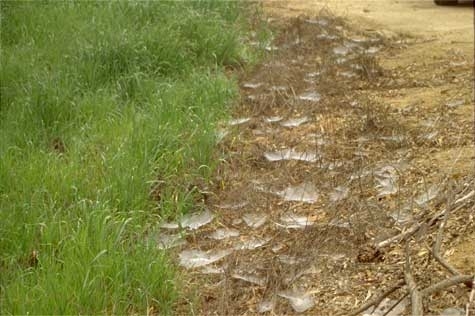
While many people fear spiders or dislike their cobwebs, most spiders are beneficial to have around – even in the home! Spiders are predators of many insect pests and rarely cause harm to people. The only medically significant spiders in California are brown and black widows. While these spiders have the potential to cause harm, it is rare that they will bite, even in areas where they are very common. Like most spiders, they prefer to stay hidden and avoid people.
Some common web-spinning spiders you might encounter outdoors include:
- Funnel weavers: feed during the day and night near the ground in most types of vegetation, including low-growing plants and trees. Spin funnel-shaped webs, often with several-inch-wide, flat extension covering plants or soil.
- Sac spiders: spin silken tubes or sacs under bark, among leaves, and in low plants or on the ground, where they hide during the day or retreat after hunting. They are typically nocturnal, medium-sized, pale spiders with few markings.
- Garden spiders: feed on insects that fly, fall or are blown into their webs. Elaborate silken webs are spun in concentric circles.
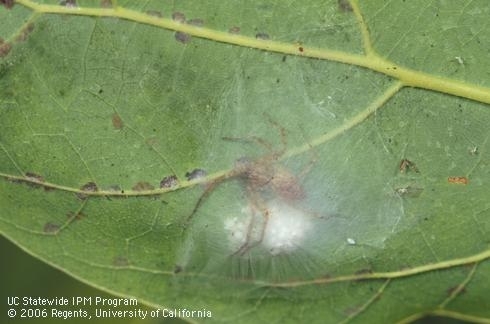 Female sac spider or two-clawed hunting spider with her eggs. (Photo: David Rosen)
Female sac spider or two-clawed hunting spider with her eggs. (Photo: David Rosen)
- Dwarf spiders: prey on insects that fall, walk or land in their webs. They are diurnal (day active) spiders found in the plant canopy and among litter on the ground. Dwarf spiders produce sheet-like webs on the surface of plants or soil.
- Comb-footed spiders: feed on insects that walk or fly into their webs. They almost always are found hanging upside down by their claws in irregularly spun, sticky webs, waiting for prey. Generally they have a soft, round, bulbous abdomen and slender legs without spines.
Unwanted cobwebs can be swept, mopped, hosed or vacuumed up. Insecticides should not usually be used against spiders outdoors and don't provide good control anyway.
For more information about spiders in and around the home, visit the Pest Notes: Spiders.
This story first appeared in the UC Integrated Pest Management Program's Pests in the Urban Landscape blog.
- Author: Jeannette Warnert
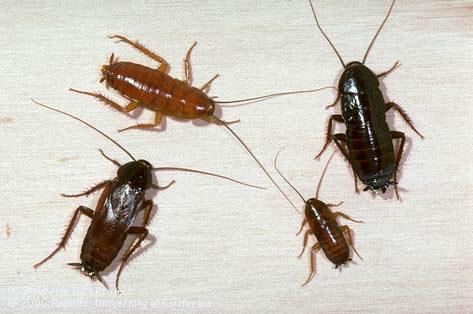
Cockroaches, ants and flies are three common outdoor pests that will enter homes when they have the opportunity, said UC Cooperative Extension urban integrated pest management (IPM) advisor Andrew Sutherland.
Oriental cockroaches, usually black or dark brown, are found throughout the U.S. They live and breed in dark, damp outdoor locations. Reddish-brown Turkestan cockroaches, originally from central Asia, are now well established in California. They live outside eating decaying plant and animal matter, finding safe harbor in water meter, irrigation and electrical boxes, cracks and crevices. American cockroaches live in warm and humid underground structures, such as sewers and storm drains.
If your home isn't well-sealed, they will walk right in.
Sutherland recommends using IPM strategies to prevent cockroach infestations, starting with prevention. Reduce moisture around the home, especially within the first couple of yards of the perimeter. Remove as much food as possible from around the home.
“You never want to leave pet food outside. If you have a fruit tree, make sure the fruit is not accumulating in the yard,” he said.
Add door sweeps or door brushes to close the gap underneath doors. Garages should be sealed with a flexible threshold seal.
“Spraying cockroaches with pesticides will not fix the problem,” he said. “If you have exterior doors with a one-inch gap, it doesn't matter how many pesticides you apply to cockroaches, they are still going to come in through the door. If you want to treat cockroaches with pesticides, bait works best.”
Readily available gel and granular baits are very effective.
Ants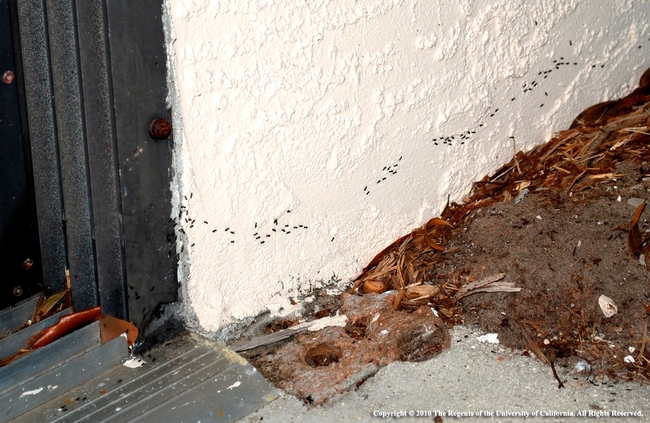
Argentine ants are native to South America, but they have been introduced all over the globe. The tiny black insect lives in large colonies, so their trails can resemble crowded superhighways. Researchers have discovered that they tend to enter homes two times of the year: When the first rain of the season floods their nests, and when it is hot and dry in the summer.
“Sometimes they will even move their entire brood into a protected area indoors, within a wall or cabinet void,” Sutherland said. “Argentine ants live and breed outside. If you're seeing them indoors, it's because they are foraging on a resource or they're temporarily moving their colony to avoid inhospitable conditions.”
The best control strategy is prevention. Irrigated landscape favors Argentine ants. A drought-tolerant or xeriscape landscape will be less attractive to them. Removing food sources is more difficult with ants. Sap-sucking insects like aphids, mealybugs, whiteflies and soft scale deposit a sweet, sticky residue that ants love.
“If you're able to control the sap-sucking insects, you'll control the ants. Likewise, if you control ants, you'll probably see a reduction in sap-sucking insects,” he said.
Sutherland suggests avoiding regular pesticide spray programs for pest control because of the ecological damage that results when runoff flows into storm drains, creeks and other waterways. As with cockroaches, baits can be very effective.
“Ants are social insects. If an ant consumes a bit of insecticidal bait, it's going to share it with its nestmates. With baits you can actually kill an entire ant colony, where with sprays, at best you're going to kill the ants that cross chemical,” Sutherland said.
Sometimes, you might have an “ant emergency,” a swarm of ants that suddenly appears inside.
“There are safe steps to take,” Sutherland said. “I keep a spray bottle with a 10% soap solution. I spray it wherever I see ants and wipe them off. This works better than a contact insecticide because you also erase the pheromone trail the ants are using to find food or water. “
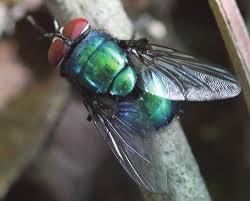
Many species of colorful metallic blowflies are found the world over. To control them, turn to prevention.
“Blowflies really like pet waste,” Sutherland said. “One deposit of waste can sustain a lot of flies. If you have pets, pick up and dispose of their waste.”
As a secondary control, be diligent with structural exclusion. Make sure the doors are closed, window screens are in good repair and screen doors fit well. You can buy aerosol cans of insecticide in home stores, which kills on contact as insects fly through mist. But it is cheaper and safer to kill them with a fly swatter or rolled up paper.
Learn more:
Summertime Household Pests, by Andrew Sutherland, UC IPM webinar on YouTube
UC IPM Pest Notes:
Cockroaches
Ants
Flies
Dozens of other pests
- Author: Belinda Messenger-Sikes
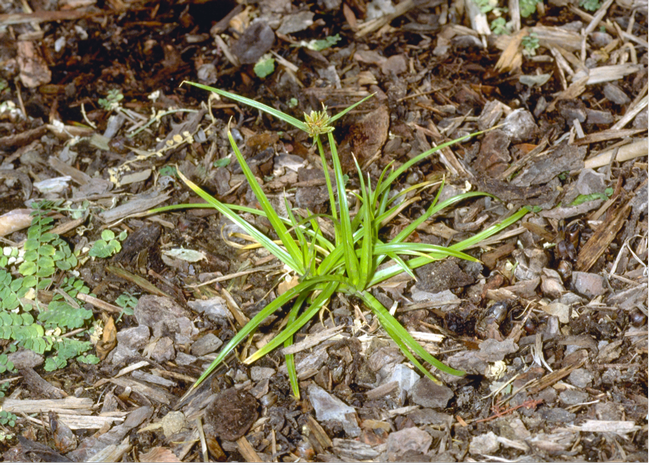
Yellow nutsedge grows throughout California while purple nutsedge can be found mostly in the south of the state and the Central Valley. Once established, nutsedge is difficult to control because it forms tubers in the soil that can live up to three years. The best approach is to prevent the weed's establishment and spread.
Purple nutsedge. (Photo: Joseph DiTomaso)The two most common weedy species of nutsedge in California are yellow nutsedge, Cyperus esculentus, and purple nutsedge, C. rotundus. Yellow nutsedge grows throughout California, while purple nutsedge is more often found in the southern coastal and desert portions of the state as well as the Central Valley.
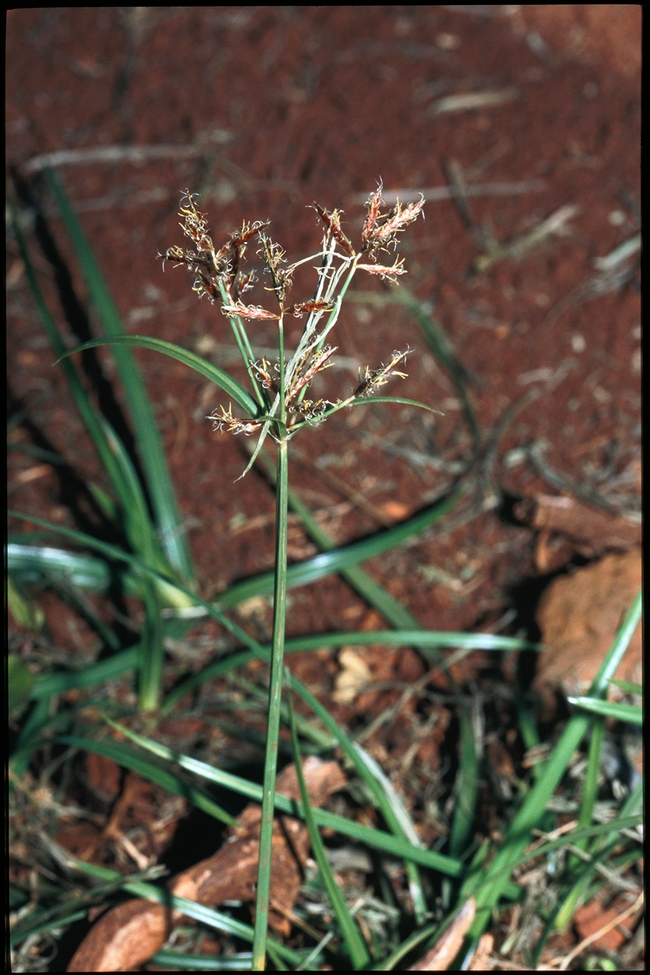
Yellow nutsedge produces round, smooth, brown or black tubers that can be up to 7/16 inch (11 mm) wide at maturity. Only a single tuber forms at the end of a rhizome, and the tubers have a pleasant almond taste.
Red or red-brown scales cover purple nutsedge tubers. The tubers grow in chains with several tubers on a single rhizome, and they have a bitter taste. Purple nutsedge tubers are typically up to 1/2 inch (10-12 mm) wide but can be 7/16 to 1-1/3 inch (10 to 35mm) long.
The best approach for avoiding nutsedge problems is to prevent establishment of the weed in the first place. Once established, nutsedge plants are difficult to control.
To help you identify and better manage this troublesome weed, UC IPM has updated the Pest Notes: Nutsedge. This fact sheet was revised by UCCE San Diego Area Integrated Pest Management Advisor Emeritus, Cheryl Wilen. Updates include additional nonchemical control methods and herbicides that are effective for early nutsedge infestations.
This article was first published in the UC IPM Pests in the Urban Landscape blog.
- Author: Ann Edahl
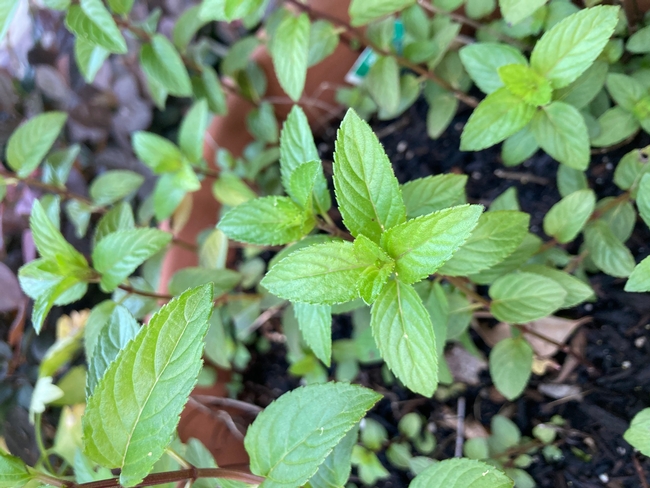
There are hundreds of varieties of mint. The two most common are peppermint (Mentha piperata) and spearmint (Mentha spicata). Peppermint is used mostly for cooking, flavoring, and oils — for example, in gum, soaps and candy. Spearmint is often used fresh, such as in teas, other drinks and sauces (mint sauce, anyone?).
Other mint types that are usually easy to find include apple mint, pineapple mint and chocolate mint. And yes, chocolate mint, a type of peppermint, really does smell like a chocolate mint when you rub a leaf between your fingers!
Mint is a hardy perennial, meaning the plant comes back every year, and it can handle temperatures well below freezing. Depending on the variety, mint plants grow about one- to two-feet tall. They can grow in lots of different types of soil but prefer rich soil. Mint grows in full sun to part shade and needs moderate water. Its ability to thrive in part shade is a plus for many gardeners.
Although mint is often disease and pest free, it can be susceptible to rust and powdery mildew, two diseases caused by fungi. Some insects can also cause damage to mint, including aphids, leafhoppers, thrips, spider mites, mint caterpillar and mint root borer. See the University of California IPM (integrated pest management) mint page, linked below, for more information and tips on controlling these diseases and pests.
How do you grow mint? Mint spreads naturally by runners, by what we call “layering” — where the mint begins rooting where the horizontal stems you see growing above the soil surface touch the soil. You can also grow mint from seed, by dividing the plant and with root cuttings — mint roots in water quite easily and you might even have luck with rooting it by sticking a stem of mint directly into the soil. Which brings us to the biggest point to consider when deciding to grow mint: its tendency to spread easily and fast!
Mint is vigorous and will spread rapidly if there is no physical barrier to stop it. To help prevent mint from becoming a nuisance, the solution is to plant it in a container. The pot should be at least six inches deep, and placing a saucer or some type of paver between the pot and the ground will prevent the mint from eventually escaping through the drainage hole. You will want to give it a good watering when the soil is dry, especially during the heat of the summer. The smaller the pot, the faster the soil will dry out. But even if you wait too long and the mint wilts, chances are it will come back. It is one hearty (and hardy) herb!
Or you can grow mint in the ground but in a large pot buried in the soil. When burying the pot, do not bury it flush with the soil, but make sure to leave a one- to two-inch lip sticking out of the ground. This will help keep the mint contained. Even then, be on the watch for mint runners trying to escape over the lip since it really, really wants to spread! Also, if planting mint in a container in the ground, make sure it's a sturdy pot. Terra cotta is okay but may disintegrate over time. Five-gallon-size paint buckets are the perfect size, deep enough that the roots of the mint cannot easily escape. Be sure to add drainage holes on the bottom if you go this route.
Now that you've planted your mint, you'll soon be ready to harvest! It's best to wait to harvest after the plant has reached three to four inches. Young leaves will have the best flavor although you can harvest at any time. To conserve the flavor in the leaves, pinch off any flowers that form.
And you're set! On our next 100-degree day, go out in the morning, pick some of those mint leaves — spearmint and apple mint are two of my favorites — steep them for a few hours in a pitcher of ice water and get ready to be refreshed!
Read more:
UC IPM. Pests in Gardens and Landscapes: Mint — Mentha ssp.
UCANR Cooperative Extension–Sacramento County. Environmental Horticulture Notes: Culinary Herb Profiles. EHN 70.
- Author: Cynthia Zimmerman
"We're not talking about one hungry plant here, we're talking about world conquest." – Seymour, Little Shop of Horrors.
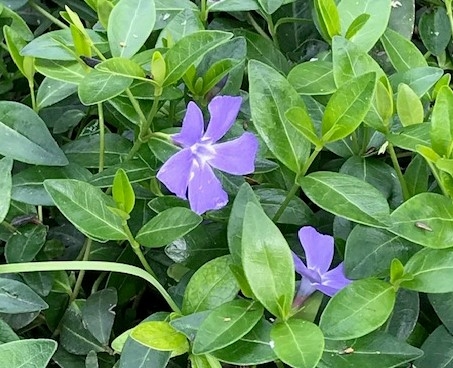
There can be undesirable consequences to the establishment of invasive species. Invasive weeds often are responsible for drastic changes to native ecosystems, such as interfering with natural habitat and food sources for animals, causing wildfires to be more frequent and intense, and lowering water tables by invasive trees that have deep rooting systems. Some plants even alter soil chemistry making it difficult for natives to survive.
These invasive species move out of their home ranges into new areas either by wind, birds or animals, or with human assistance that may be deliberate or accidental. This has been happening since the beginning of time. Humans have deliberately, and at times inadvertently, moved plant species from one region to another. With the development of high speed travel that doesn't take months to circumnavigate the globe, plants move with ease into areas where they were never before known. At times, plants that were once desirable and beneficial while under human control in gardens become a problem as they escape and start to colonize and breed in areas where they are not wanted. According to the California Invasive Plant Council, “The spread of invasive plants is one of the most significant threats to the native plant species and vegetation communities of the state, second only to habitat destruction.”
It's up to all of us to take some responsibility for reducing the problems caused by invasive species. One simple step is careful selection of garden plants by using species that are not likely to be invasive. The following plants are at the top of the list of invasive plants that should not be planted in California:
- Pampas grass (Cortaderia selloana)
- Green fountain grass (Pennisetum setaceum)
- Mexican feather grass (Stipa/Nassella tenuissima)
- Highway iceplant (Carpobrotus edulis)
- Periwinkle (Vinca Major)
- Yellow flag iris (Iris pseudacorus)
Instead of the above listed plants, try the alternatives shown on the Plant Right invasive plant website.
For a list with pictures of suggested non-invasive plants for California, take a look at Plant Right's better plant choices.
For further information about invasive plant species and what you can do to help, see the following websites:
Don't Plant a Pest! Central Valley
Don't Plant a Pest! California Invasive Plant Council (cal-ipc.org)
Invasive Plant Checklist for California Landscaping (pdf)
The 39 Most Invasive Plant Species in California
16 Invasive Species Sold at Garden Centers You Should Never Buy
Native Plants and Invasive Species
(Originally written April 2021. Updated May 2024)

